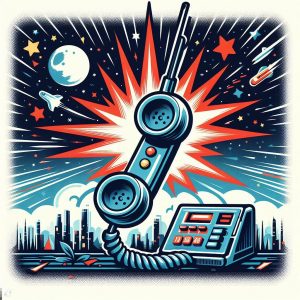Introduction
Call blasting refers to the mass transmission of pre-recorded phone calls or messages to a large list of contacts simultaneously. It allows businesses and organizations to quickly disseminate important information to hundreds or thousands of recipients at once.
For companies, call blasting provides an efficient way to connect with customers, promote products and services, send reminders about appointments or payments, convey urgent notifications, and more. It eliminates the time and effort needed to place individual calls, making it more cost-effective than manual calling.
Call blasting also enables useful data collection – businesses can track metrics like call duration, geographic location of recipients, times of highest engagement, and more. These insights help enhance future calling campaigns.
Overall, responsible use of call blasting fuels stronger customer relationships, brand awareness, and sales revenue. However, illegal spam calling has caused negative perceptions around robocalling, putting the onus on businesses to use call blasting legally and transparently.
How Call Blasting Works
Delivering messages via call blasting involves a simple, automated process:
Step One: Creating a Contact List
The first step is pulling together a contact list in a CSV file. This should contain accurate customer phone numbers, preferably cell numbers, to achieve high engagement levels. Contacts must have consented to receiving calls/messages from the business through opt-in checkboxes or submissions.
Step Two: Recording the Message
Next, the pre-recorded voice message that recipients will hear is created. Businesses can choose to record a human voice message that sounds more authentic or use a text-to-speech generator to create robotic messages. In either case, brevity and clarity are vital.
Step Three: Uploading the Message
The voice message file gets uploaded into a call blasting software that allows sending simultaneous calls. Many customer relationship management (CRM) tools have built-in call blasting functions. There are also third-party voice broadcasting applications specifically for mass calling.
Step Four: Simultaneous Calling
At the scheduled campaign time, the software will automatically dial the contact list and play the pre-recorded message. Thousands of calls can be placed concurrently.
Step Five: Recipient Response
Recipients can listen to the entire message or hang up at any time. Some call blasting tools have interactive features so recipients can provide additional feedback through touch tone responses or verbally. The software tracks metrics like call duration for analysis.
When to Use Call Blasting
Call blasting has diverse applications for communicating vital information to large customer groups quickly:
Disseminating Information
General announcements about new products, policy/price changes, website updates, etc. Error notifications and recalls also fall under important info to push out broadly through call blasting.
Sending Reminders
Follow-up reminders about upcoming or missed appointments, deadlines for payments/paperwork, renewal notices, etc. can be dispatched to customers easily.
Urgent Notifications
Weather delays, delivery issues affecting multiple clients, system outages, and other time-sensitive notifications warrant quick call blasts.
Promoting Services/Products
Brief calls to advertise special deals, sales events, limited-time offers, new product launches, etc. enable businesses to tap into call blasting for promotion.
When Not to Use Call Blasting
While call blasting is extremely useful when deployed correctly, some inappropriate uses can backfire:
Legal Issues
Violating telecommunications and consumer protection laws with illegal spam calling carries hefty federal fines. Businesses must follow TCPA guidelines.
Unclear Messages
Overly wordy, confusing voice messages with vague calls-to-action frustrate customers and damage brands.
No CTA/Contact Details
Not including a strong CTA telling recipients what to do next or service phone numbers for follow-up questions reduces call effectiveness.
Best Practices for Call Blasting
Following best practices and guidelines ensures call blasting bolsters rather than harms customer relations:
Use Calling Software
Invest in voice broadcasting software with built-in compliance features, scheduling, custom reporting, etc. CRMs like Salesforce also have call blasting.
Personalize Messages
Merge customer names/other details into messages using phone number databases for a personalized feel. Segment contacts by preferences too.
Test Messages
Check the caller ID name displaying during test calls. Refine scripts for clarity. Confirm the number/department customers should contact post-call.
Monitor Metrics
See which messages earn greater engagement based on call duration, geographic trends, times of day, etc. Refine future calling campaigns accordingly.

Legal Considerations and Compliance
Federal and state regulations impose many constraints around call blasting to protect consumer rights and privacy. Key laws include:
FTC Regulations
The FTC’s Telemarketing Sales Rule prohibits pre-recorded sales calls without written consent. All opt-in policies and calling practices must abide by FTC guidelines.
TCPA Guidelines
The Telephone Consumer Protection Act (TCPA) bans calls/texts sent using auto-dialers or pre-recorded voices without “prior express written consent.” Substantial non-compliance fines apply.
Customer Consent
Businesses must retain proof of opt-in consent across communication channels. Consent forms should use simple language clearly allowing informational or promotional calls.
Staying abreast of the latest TCPA case law developments is also vital for legal compliance. Support from telecom attorneys helps too.

Conclusion
When executed lawfully and conscientiously, call blasting gives companies a powerful communication channel for critical brand messaging and customer engagement. Blast calling eliminates laborious manual calling and provides helpful feedback through detailed reports too. However, businesses must invest time into honing brief, compelling call scripts focused on end goals for recipients. Overall though, embracing call blasting thoughtfully yet aggressively where appropriate gives brands an excellent opportunity to drive results.